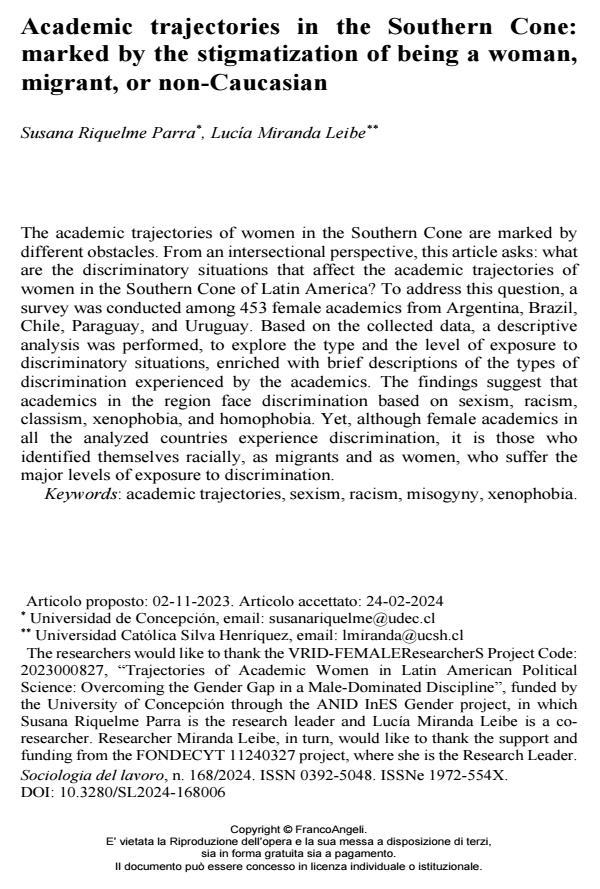Academic trajectories in the Southern Cone: marked by the stigmatization of being a woman, migrant, or non-Caucasian
Titolo Rivista SOCIOLOGIA DEL LAVORO
Autori/Curatori Susana Riquelme Parra, Lucía Miranda Leibe
Anno di pubblicazione 2024 Fascicolo 2024/168
Lingua Inglese Numero pagine 19 P. 112-130 Dimensione file 234 KB
DOI 10.3280/SL2024-168006
Il DOI è il codice a barre della proprietà intellettuale: per saperne di più
clicca qui
Qui sotto puoi vedere in anteprima la prima pagina di questo articolo.
Se questo articolo ti interessa, lo puoi acquistare (e scaricare in formato pdf) seguendo le facili indicazioni per acquistare il download credit. Acquista Download Credits per scaricare questo Articolo in formato PDF

FrancoAngeli è membro della Publishers International Linking Association, Inc (PILA)associazione indipendente e non profit per facilitare (attraverso i servizi tecnologici implementati da CrossRef.org) l’accesso degli studiosi ai contenuti digitali nelle pubblicazioni professionali e scientifiche
The academic trajectories of women in the Southern Cone are marked by different obstacles. From an intersectional perspective, this article asks: what are the discriminatory situations that affect the academic trajectories of women in the Southern Cone of Latin America? To address this question, a survey was conducted among 453 female academics from Argentina, Brazil, Chile, Paraguay, and Uruguay. Based on the collected data, a descriptive analysis was performed, to explore the type and the level of exposure to discriminatory situations, enriched with brief descriptions of the types of discrimination experienced by the academics. The findings suggest that academics in the region face discrimination based on sexism, racism, classism, xenophobia, and homophobia. Yet, although female academics in all the analyzed countries experience discrimination, it is those who identified themselves racially, as migrants and as women, who suffer the major levels of exposure to discrimination.
Parole chiave:academic trajectories, sexism, racism, misogyny, xenophobia.
- Where do gender differences lie? Critically reviewing the research literature on academic employment from a gender standpoint Rodrigo Rosa, in Journal of Gender Studies /2025 pp.1
DOI: 10.1080/09589236.2025.2587156
Susana Riquelme Parra, Lucía Miranda Leibe, Academic trajectories in the Southern Cone: marked by the stigmatization of being a woman, migrant, or non-Caucasian in "SOCIOLOGIA DEL LAVORO " 168/2024, pp 112-130, DOI: 10.3280/SL2024-168006